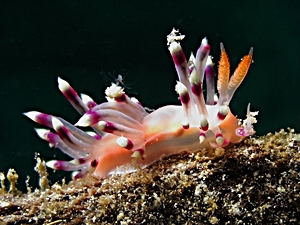
Flabellina exoptata (Aeolidia) from Malaysia.
Picture: Choh Wah Ye (Source).
 Flabellina exoptata (Aeolidia) from Malaysia. Picture: Choh Wah Ye (Source). |
With over 3000 known species the nudibranchs, between 2 and 60 cm in size, are by far the most species-rich subgroup of opisthobranchs (Opisthobranchia).
Their very large diversity of colours, making those slugs a favourite photo object of divers, has made the nudibranchs so famous, people tend to call all sea slugs nudibranchs.
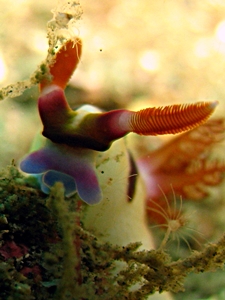 Head and rhinophores of Nembrotha purpu- reolineata. Picture: Choh Wah Ye (Source). |
This, of course, is not true. There are slug forms in all other groups of opisthobranchs, for example the colourful (and ferocious) slug family Aglajidae in the Cephalaspidea group, the sea angels (Clionidae) in the wing snail group ('Pteropoda') and also among sap-sucking slugs (Sacoglossa) there are many shell-less forms. There is even the group Onchidiidae, which actually are pulmonate snails (Pulmonata), but, living in the sea, they could with some justification be called sea slugs.
Nudibranchs on the other hand, are the most naked of shell-less gastropods. Their pallial cavity has been reduced and the primary gill is also absent. Nudibranchs breathe either through their skin or they use the tuft of secondary gills many species carry on the tail end of their back.
The dorsal appendages of nudibranchs also are referred to as cerata (κερόϛ - Greek: The Horn). Extensions of the main digestive gland go deep into the cerata, so those are connected not only to the respiratory system of the snail, but also to its digestive system. The cerata are also very important in defensive strategies of nudibranchs.
![]() Bill Rudman:
Cerata (ceras)
in aeolids on seaslugforum.net.
Bill Rudman:
Cerata (ceras)
in aeolids on seaslugforum.net.
At their head, nudibranchs have one or two tentacles to provide tactile information, as well as olfactory and taste information on the surroundings. Also, there are the rhinophores to provide chemical stimuli, especially olfactory information. Additional tentacles can be present on the foot's rim.
![]() Movie: "The
Lynx Nudibranch" (Phidiana lynceus). Source:
Coral Morphologic.
Also not the oyster's (Spondylus americanus) pallial ocelles!
Movie: "The
Lynx Nudibranch" (Phidiana lynceus). Source:
Coral Morphologic.
Also not the oyster's (Spondylus americanus) pallial ocelles!
Like all opisthobranchs, the nudibranchs also are hermaphrodites, whose mating takes place reciprocally.
|
Nothing for weak nerves: A nudibranch (Hermissenda crassi- cornis) on the hunt for other nudibranchs. Source: YouTube. |
Generally, nudibranchs are predators or they feed on carrion. There is a more or less noticeable specialization in food. Some nudibranchs feed on sponges, others on bryozoans, polyps or jellyfish, tunicates, barnacles or sea anemones. Some nudibranchs even feed on other sea slugs, other nudibranchs or even smaller ones of their own kind.
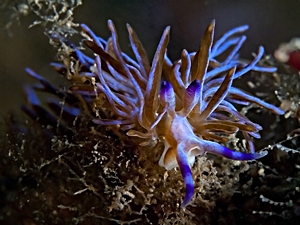 Pteraeolidia ianthina (Aeolidia) from Australia. Picture: Doug Anderson (Source). |
While it is known of numerous species of sap-sucking slugs (Sacoglossa), that they can incorporate chloroplasts from plant cells the fed on into their own cells, on the other hand there are nudibranchs (such as Pteraeolidia ianthina), which have underwent a symbiosis with zooxanthelles. Zooxanthelles are symbiotic brown algae (Dinoflagellata), which equally provide the slug with photosynthetic products. Partly, the nudibranch acquires the zooxanthelles probably from its food, jellyfish, in which those zooxanthelles already live. Partly, it remains unclear where nudibranch zooxanthelles come from. Contrary to sacoglossans' chloroplasts nudibranch zooxanthelles are complete cells, not just organelles.
Zooxanthellen also provide giant clams (Tridacna) with photosynthesis products. Reef-building corals also use zooxanthelles. While usually every host organism is able to do without the zooxanthelles, to those corals they are vital - only with their help the corals will manage to build their reef, as this needs very many nutrient resources.
![]() Bill Rudman:
Zooxanthellae in
nudibranchs on seaslugforum.net.
Bill Rudman:
Zooxanthellae in
nudibranchs on seaslugforum.net.
Hooded Nudibranch or Lion Head Slug (Melibe leonina)
width="300">
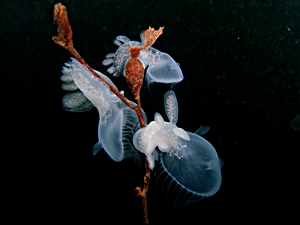 Lion head slugs on the search for food on a kelp plant. Picture: Jackie Hildering (Source). |
A very astonishing view is a hooded nudibranch (Melibe leonina) on the look for food. The small slug about 5 cm long can be found on the west coast of America, from Alaska to Baja California in the south. The slug is almost translucent and has leaf-like dorsal appendages serving as gills and filled with a network of blood vessels. The slug lives in the kelp forest, where it crawls around on plants, also swimming between them in a characteristic turning and winding manner. During mating season in late summer, thousands of those small slugs can be observed sitting on the kelp plants.
![]() Jackie Hildering:
Thousands of hooded nudibranchs at the British Columbia coast.
Jackie Hildering:
Thousands of hooded nudibranchs at the British Columbia coast.
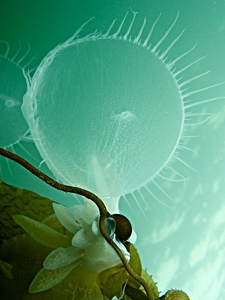 Hardly to be recognized as a gastropods: A hooded nudibranch (Melibe leonina) catching plankton. Picture: Jackie Hildering (Source). |
The lion head slug has neither a radula nor a jaw, as both have been reduced completely. Instead, its mouth has been formed into a conspicuous hood framed by rim tentacles, which gave the species the alternative name lion head slug.
Specimens swimming on the ocean surface might well be mistaken for jellyfish because of the uncommon body form.
Melibe leonina mainly lives on zooplankton and small crustaceans living on the kelp plants, such as amphipods, phyllopods and others, but also on small molluscs and sometimes even small fish. First the snail covers the prey with its hood, and then it closes it, the mouth tentacles preventing the prey from escaping. Sometimes the hooded nudibranchs catch plankton from the open water by opening the hood wide and using it as a net. Relatives of the hooded nudibranch, like the Indonesian species Melibe mirifica, search the ground for food like a vacuum cleaner.
| width="300" height="250">
A swimming hooded nudibranch (Melibe leonina). Source: YouTube.com. |
An the hood's side the small rhinophores resembling ears can be seen. Like most opisthobranchs, hooded nudibranchs only have a very bad eyesight and can barely see light and dark. So, on the search for a mate, they use pheromones on terpenoid base, which for humans has a fruity scent. This scent of lion head slugs not only has the task of attracting mating partners, but also to deter predators. Lion head slugs spread the scent when they are disturbed and cannot save themselves by swimming away.
Nearly untypical for a nudibranch, the hooded slugs do not acquire this attracting or deterrent agent with their food, are or by basic compounds from their food, but entirely produce it themselves. The agent's production is independent from the food source.
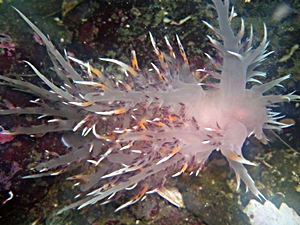 Tree slug (Dendronotus iris) from British Columbia. Picture: Dan Hershman (Source). |
Terpene based agents are not only produced by gastropods, also plants make them - when they are harmed by herbivores, they use it to attract predators to feed on the herbivores.
|
|
Barsby, T.; Linington, R. G.; Andersen, R. J. (2002): "De Novo terpenoid biosynthesis by the dendronotid nudibranch Melibe leonina". Chemoecology 12: 199 - 202. | |
|
|
Jörg Degenhardt et al.: Die Funktion von Terpenen bei der Verteidigung der Pflanze. AG Pharmazeutische Biotechnologie, Universität Halle-Wittenberg. (Accessed: 12.12.10). |
Systematically, lion head slugs and their relatives, the Thethydidae family, belong to the tree slugs (Dendronotida), called that way because of the branch-like cerata and not to be confounded with the terrestrial helicid tree snails (Arianta arbustorum).
![]() Jackie Hildering:
The Marine Detective.
Jackie Hildering:
The Marine Detective.
![]() Glen Miller:
Hooded nudibranch swimming. Video on
The Marine Detective.
Glen Miller:
Hooded nudibranch swimming. Video on
The Marine Detective.
Without neither a protective shell nor an operculum, nudibranchs in the sea appear to be the optimal prey. But that is not so, especially in this group some very different defence strategies have evolved, making survival possible for the slugs without a shell.
Similar to sea hares and sacoglossans, nudibranchs can acquire poisonous agents from their food and use it for their own defence. Especially nudibranchs feeding on sponges have found some effective toxins to use for their own benefit. A change in food usually also goes together with a change in the composition of toxins. Some species even are able to produce toxins themselves. Their composition is independent of the slug's food. Some nudibranchs even can produce acids to deter predators.
|
|
Edmunds, M. (1968): "Acid secretion in some species of Doridacea (Mollusca, Nudibranchia)". Proceedings of the Malacological Society of London 38: 121 - 133. |
Some sea slugs even can discard their cerata, like a lizard its tail to busy the predator, while the slug escapes.
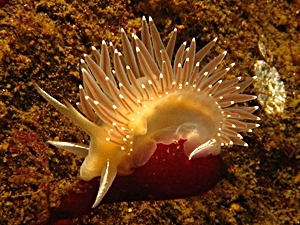 Flabellina trophina, US north-western coast. Picture: Dan Hershman (Source). |
Best known is the ability of nudibranchs to acquire complete cells from their prey and to use them for their own defence. The blue ocean dragon or sea swallow (Glaucus atlanticus) eats smaller jellyfish (Siphonophora) whole. In larger one it attacks the tentacles of all things, disregarding the fact that those may inflict harmful stings to other animals with their nettle cells (nematocysts).
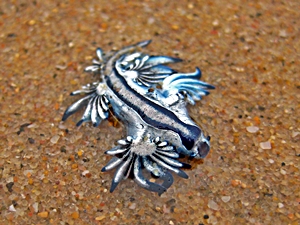 Blue ocean dragon (Glaucus atlanticus) from South Africa. Picture: Source. |
The slug not only manages not to be stung by the nettle cells, but it even can disarm them and transport them into its cerata past the intestinal extensions (see above). There they are discharged when a predator tries to attack the slug. Glaucus assembles the most potent nettle cells of the jellyfish, so finally it is more poisonous than the jellyfish itself, which is something, as Glaucus atlanticus feeds on the most dangerous of jellyfish, such as the Portuguese man o' war (Physalia physalis), the sailor jellyfish (Velella velella) and the blue button (Porpita porpita).
Besides, it also feeds on violet snails (Janthina janthina) and even smaller ones of its own kind.
|
|
Bill Rudman: Glaucus atlanticus auf seaslugforum.net. |
Most interestingly the blue dragon slug is darkly coloured at its foot and light coloured at the back (exactly the other way round as it should be expected). That is because the slug swims by a gas-filled bladder at its ventral side, causing it to swim on the back. By the way, Glaucus carries its cerata laterally, other than other nudibranchs, which gives the animal its conspicuous dragon-like appearance.
Among nudibranchs there are several species performing bioluminescence: Some of their body parts emit light. Among those there is Plocamopherus imperialis, glowing when it is disturbed, and Phylliroe bucephalum, a planktontic nudibranch species hardly recognizable as a sea slug, feeding on jellyfish.
![]() Rob Powers:
A picture of
Phylliroe from the movie "Aliens of the Deep" by James Cameron.
Rob Powers:
A picture of
Phylliroe from the movie "Aliens of the Deep" by James Cameron.
![]() Bill Rudman:
Phylliroe
bucephalum on seaslugforum.net.
Bill Rudman:
Phylliroe
bucephalum on seaslugforum.net.
![]() Bill Rudman:
Plocamopherus
imperialis on seaslugforum.net.
Bill Rudman:
Plocamopherus
imperialis on seaslugforum.net.
In the systematics according to Bouchet et al. (2005) the nudibranchs together with a family of side-gill slugs ('Notaspidea') were joined to form the clade Nudipleura. On this occasion, the 'Notaspidea' was disbanded for phylogenetic reasons.